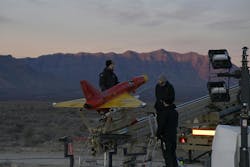QinetiQ’s Rattler Supersonic Target Mkl simulates high-energy laser threats
Laser Focus World: Can you introduce QinetiQ and describe your involvement in the U.S. Department of Defense’s (DoD) HELM Rattler program?
Owen Price: QinetiQ is an integrated global defense and security company focused on mission-led innovation. Our goal is to protect lives by serving the national security interests of our customers. We employ more than 8500 highly skilled people and are committed to creating new ways of testing technologies, systems, and processes to ensure they meet operational needs. QinetiQ enables customers to deploy new and enhanced capabilities with the assurance they will deliver the required performance.
In collaboration with the DoD, we flew the first two Rattler Supersonic Target (ST) Mkl variants, as part of the High-Energy Laser Measurement (HELM) Rattler program and a QinetiQ-funded R&D project to continue to meet the requirements of our customers.
QinetiQ customized the platform to support the DoD’s HELM Rattler Program by integrating a third-party target board to measure high-energy laser characteristics in flight at supersonic speeds.
We demonstrated our technical and operational expertise and teamwork by launching the Rattler ST Mkl—as requirements for more realistic, instrumented threat representation are becoming increasingly important.
LFW: Can you give us some background about the HELM Rattler program?
Price: This $10M program started in February 2022. The DoD required a supersonic target to support the development of high-energy laser (HEL) systems in response to emerging and evolving threats.
Uncrewed missile targets are integral to the DoD’s test and evaluation program to defend against fast, low-to-the-horizon threats and exemplify QinetiQ’s ability to design and engineer realistic targets that represent anti-radiation missiles and tailor them to the needs of our customers.
The successful flights aided the program’s Rattler variant development by presenting opportunities for the White Sands Missile Range High-Energy Laser Systems Test Facility’s (HELSTF) Tracking Illuminating Laser System to acquire, track, and queue from a supersonic target at a short slant range to provide the first data for this design variant of the Rattler Supersonic Target Mkl target.
LFW: What kind of high-energy laser weaponry is being tested?
Price: HELM Rattler “Supersonic” is a DoD joint program with applications across its suite of defensive laser systems. We can’t be more specific than that, unfortunately.
LFW: What should everyone know about the Rattler Supersonic Target and its new design?
Price: Rattler ST-Mkl is part of our transition to service Internal R&D updates on the Initial Operational Capability (IOC) of Rattler. Its design improves reliability, simplifies field operations and operational safety, as well as payload flexibility, and reduces costs.
Since it can emulate a variety of advanced missile threats, Rattler ST is a cost-effective supersonic target platform designed for threat replication, operational training, and system evaluation.
Our portfolio of targets are built to customers’ requirements to meet current and evolving threats they need to defend and train against to deliver realistic threat representation.
LFW: Biggest challenges with the new design?
Price: The biggest challenge of design development projects for low-cost targets is limited flight test opportunities, which tends to lead to cautious, incremental design changes.
LFW: Applications?
Price: Rattler ST-Mkl can simulate a wider variety of threats, depending on the flight profile selected and payload. HELM Rattler flight scenarios are customer-dependent and perhaps more heavily constrained by the laser system under test, for example, to optimize beam spot size on target or operational safety concerns.
LFW: What’s next?
Price: We expect more DoD programs to find applications for HELM Rattler targets. Rattle ST-Mkl is a disruptive product and likely to displace competition within niche applications where operators seek to mimic specific threat systems’ signatures, such as terminal phase or air-launched separation and flyaway.
